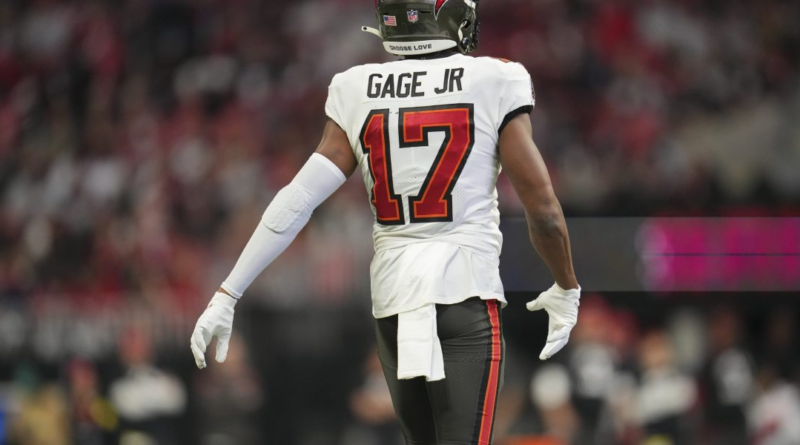Russell Gage’s injury highlights the NFL’s concussion problem and how it hurts players long-term
Merely two weeks after Buffalo Bills safety Damar Hamlin was rushed off field due to cardiac arrest, Tampa Bay Buccaneers wide receiver Russell Gage was hospitalized with a concussion and neck injury after a hit during Monday’s playoff game against the Dallas Cowboys. The incident highlights the ongoing concern regarding concussions and player safety in the National Football League.
Although the number of reported concussions in the NFL has declined since it started tracking them during the 2015 season, the protocol was once again called into question following Miami Dolphins quarterback Tua Tagovailoa’s multiple head injuries earlier this season. Those injuries, one of which was later reported by the team to be a “back injury,” prompted the league to revisit its concussion protocol.
In the revised policy, ataxia, or “abnormality of balance/stability, motor coordination, or dysfunctional speech” as a result of a concussion–which Tagovailoa demonstrated after returning to the game in Week 3–has been added to the list of “no-go” signs and symptoms, which means any player displaying these symptoms will not be allowed to return to the game.
Essentially, the revised protocol closes a loophole that allowed players who had gross motor instability to return to the game if doctors determined the player’s stumbling was caused by something other than a head injury.
“We want to ensure that all of our medical professionals not only adhere to the protocols as written, but also understand that they serve the players as patients,” the NFL Players Association wrote in response to recent changes.
But it remains to be seen whether these changes are enough and whether they will ultimately keep players safe in such a high-contact sport. While severity is variable, concussions are considered a subset of mild traumatic brain injuries. Treatment usually involves rest; however, too much rest can prolong recovery.
“Typically too much activity makes symptoms worse, but too little activity can have the opposite effect, by not allowing the brain to heal as quickly,” explains Dr. Richard Figler, director of the Concussion Center and staff physician in the Center for Sports Medicine at the Cleveland Clinic. “We’re really trying to find that sweet spot where people can do things without provoking their symptoms … There’s good evidence to suggest that early exercise, that does not provoke symptoms is beneficial, and will help aid in recovery faster than no exercise. This may include going for a light walk, or getting on an exercise bike, but if the symptoms worsen, slowing down the activity to a point where there are minimal to no symptoms at that level of exercise.”
In most sports-related concussions, patients typically follow a progressive course of recovery over one to four weeks, says Figler. A 2018 study by Christopher D’Lauro, a cognitive neuroscientist at the Air Force Academy, and his colleagues found that “elite athletes,” such as NFL players, are able to recover from concussions faster than non-athletes. Their study showed that return-to-play time for professional athletes is generally five to seven days, compared to seven to 10 days for collegiate athletes and roughly 30 days for high school athletes.
But a shorter recovery time doesn’t equate to fewer long-term effects.
According to a 2016 study, more than 40% of retired NFL players demonstrated signs of traumatic brain injury based on MRI scans. At the time, study author Dr. Francis X. Conidi of the Florida Center for Headache and Sports Neurology and Florida State University College of Medicine in Tallahassee, Florida said, “The rate of traumatic brain injury was significantly higher in the players than that found in the general population.”
There are also long-term consequences of concussions, including an increase in neurological diseases such as dementia and Parkinson’s. While there is no known threshold to how many concussions a person can viably sustain, a 2018 study from the University of California San Francisco found that likelihood of dementia doubled following even one concussion.
Even if a person does not sustain a concussion, another 2018 study found that repeated hits to the head, or “subconcussive hits,” can increase the risk of later development of chronic traumatic encephalopathy, otherwise known as CTE, the degenerative brain condition that was found in the nearly all of deceased former football players whose brains were donated for research purposes.
The Football Players Health Study at Harvard University, a 10-year initiative that launched in 2014, has already determined three breakthroughs that may lead to the slowing down and reversing the buildup tau protein in the brain, which can lead to CTE. Those treatments include light treatment that can lead to improved sleep and less post-traumatic stress disorder symptoms; an antibody that can block the spread of Tau protein; and devices to measure the in-game impact of hits on the brain.
While there’s no surefire way to prevent concussions, especially in high-contact sports, such as football, hockey, and soccer, there are changes that can help protect the brain, head, and neck from significant trauma. Neck-strengthening exercises may help dissipate force to the head during these traumas and using helmets in good repair can also help diminish concussive risk says Figler.
Ultimately, the most impactful changes may need to be made to the game itself as Figler cites adjustments to the rules as an effective way to decrease concussions in certain sports.
“This is based on good data from injury reports that help foster rule changes that make sports safer,” he says.
Learn how to navigate and strengthen trust in your business with The Trust Factor, a weekly newsletter examining what leaders need to succeed. Sign up here.



